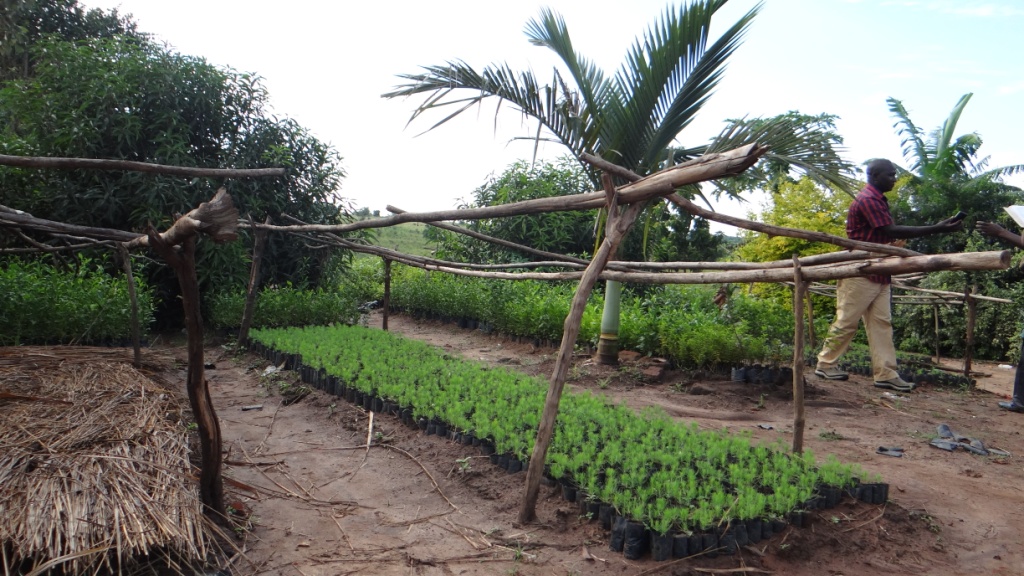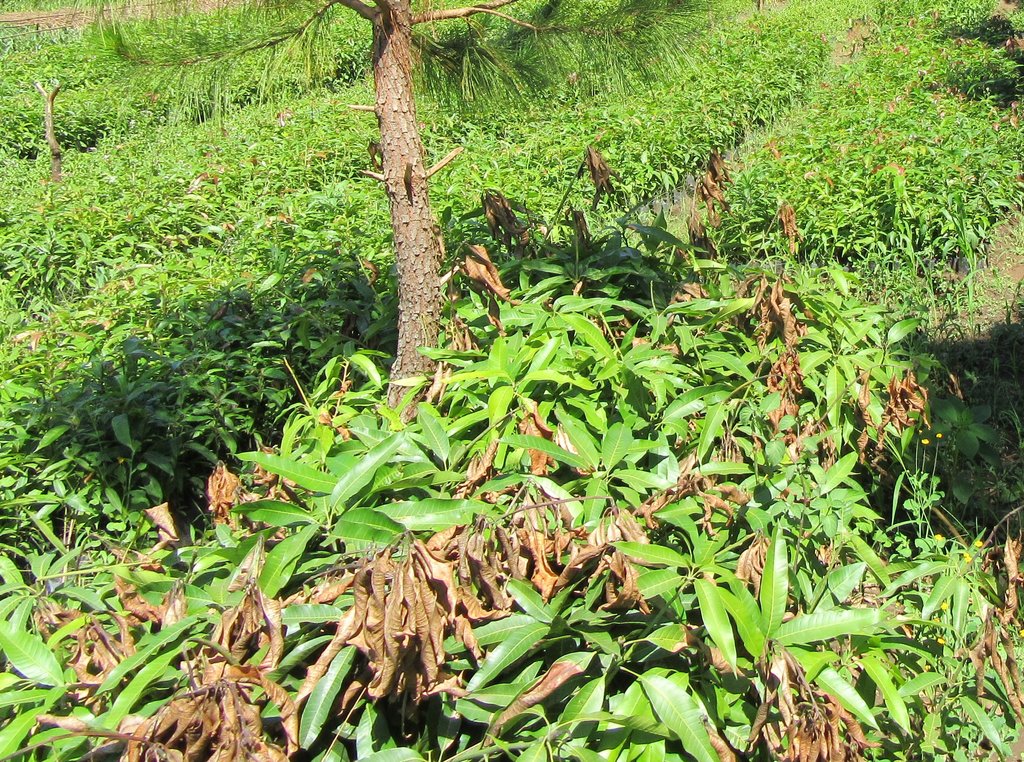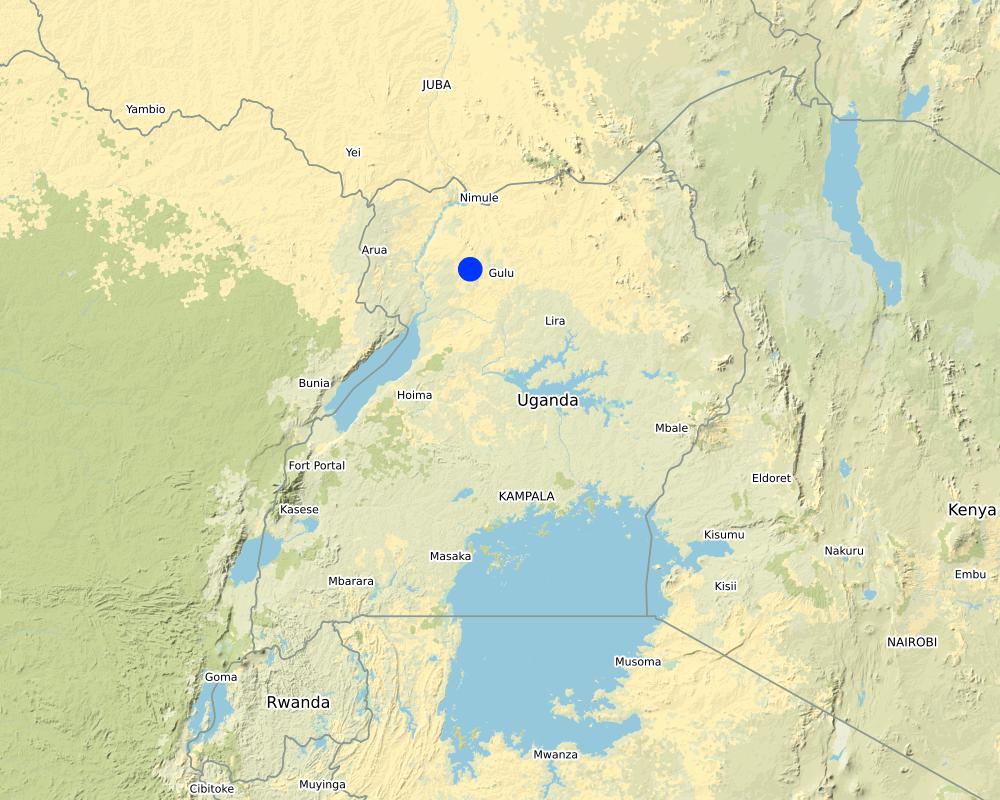Improved Tree Nursery Bed [ยูกันดา]
- ผู้สร้างสรรค์:
- การอัพเดท:
- ผู้รวบรวม: Jalia Namakula
- ผู้เรียบเรียง: Kamugisha Rick Nelson
- ผู้ตรวจสอบ: Drake Mubiru, Nicole Harari, Udo Höggel
Kayubu Kodi
technologies_2797 - ยูกันดา
ดูส่วนย่อย
ขยายทั้งหมด ย่อทั้งหมด1. ข้อมูลทั่วไป
1.2 รายละเอียดที่ติดต่อได้ของผู้รวบรวมและองค์กรที่เกี่ยวข้องในการประเมินและการจัดเตรียมทำเอกสารของเทคโนโลยี
วิทยากรหลัก
ผู้ใช้ที่ดิน:
Oyet Julius
+256782165103 / +256752165103
Tudakatuba farmers group
Pajak village, Amuru District, Northern Uganda
ยูกันดา
ชื่อของโครงการซึ่งอำนวยความสะดวกในการทำเอกสารหรือการประเมินเทคโนโลยี (ถ้าเกี่ยวข้อง)
Scaling-up SLM practices by smallholder farmers (IFAD)ชื่อขององค์กรซึ่งอำนวยความสะดวกในการทำเอกสารหรือการประเมินเทคโนโลยี (ถ้าเกี่ยวข้อง)
Uganda Landcare Network (ULN) - ยูกันดา1.3 เงื่อนไขการใช้ข้อมูลที่ได้บันทึกผ่านทาง WOCAT
วันที่เก็บรวบรวมข้อมูล(ภาคสนาม) :
09/05/2017
ผู้รวบรวมและวิทยากรหลักยอมรับเงื่อนไขเกี่ยวกับการใช้ข้อมูลที่ถูกบันทึกผ่านทาง WOCAT:
ใช่
1.4 การเปิดเผยเรื่องความยั่งยืนของเทคโนโลยีที่ได้อธิบายไว้
เทคโนโลยีที่ได้อธิบายไว้นี้เป็นปัญหาของความเสื่อมโทรมโทรมของที่ดินหรือไม่ จึงไม่ได้รับการยอมรับว่าเป็นเทคโนโลยีเพื่อการจัดการที่ดินอย่างยั่งยืน:
ไม่ใช่
2. การอธิบายลักษณะของเทคโนโลยี SLM
2.1 การอธิบายแบบสั้น ๆ ของเทคโนโลยี
คำจำกัดความของเทคโนโลยี:
Improved fruit tree nursery is a technology comprising of grafted mangoes, grafted citrus, eucalyptus and pines, established with the aim of improving household income and promotion of agro-forestry farming systems within surrounding communities to achieve environmental conservation.
2.2 การอธิบายแบบละเอียดของเทคโนโลยี
คำอธิบาย:
Tree nurseries are places where tree seedlings are propagated, managed, and grown to a transportable size. They are essential for producing quality seedlings in high quantities for rapid afforestation and sustainable land management.
In response to promoting this technology among farmers in Uganda, the Government of Uganda, through its initiatives such as Operation Wealth Creation (OWC), is promoting the growing of high value crops such as fruit trees to improve farmers’ incomes and food security. The technology is established on a gently sloping land lying on a plot of 1725 square meters, some 300 m away from a wetland used as a source of water for the nursery during the dry season. The soils here, on observation, have high clay content and are relatively deep.
The activities for establishing the nursery involved three stages:
1. clearing the bush on site, destroying all the termite mounds, ploughing the area, and levelling the mother beds established on flat or gentle rolling area to avoid water logging during the rainy season
2. preparation of the potting area and the potting medium which was done by mixing black soil with sand and manure in a ratio of 3-1-1 respectively. These activities took 2 person days to finish, followed by potting in 5cm × 12cm potting bags, taking 10 person days. The pots were then laid in a series of 1×10m long beds with paths of 0.75m between them. This activity took 2 persons days. Seeds were planted, watered and pots were covered with grass until germination after 14 days. After germination the seedlings are left for 4 months to mature until they are ready for grafting
3. grafting the then ready root stock with desired scion. The process involves cutting the root stock and scion at an angle and fitting the two together and holding them tightly with a wide plastic thread, the grafted seedlings are then placed in beds and placed in a closed housing unit with enough humidity only to be removed after 21 days. The seedlings are now placed again in rows where they are managed until ready for transportation
Maintenance activities included spraying fortnightly with pesticides and fungicides, watering with clean water twice every week, weeding and regular sorting of the seedlings to encourage proper growth. If any shade was put it is removed when the seedlings are well established to acclimatize them to open environmental conditions before they are transplanted or sold.
The tree varieties planted include improved mangoes, citrus, clonal eucalyptus and pines. Currently the nursery has over 10,000 citrus seedlings and 15,000 mango seedlings and a few seedlings of both pine and eucalyptus.
Tree nurseries are preferred by farmers because they use small land sizes, generate a lot of income, seedlings, when planted protect the environment and help in rapid production of genetically improved fruit trees in addition to offering employment to a wide spectrum of people including unskilled and skilled persons. There are notwithstanding, challenges such as lack of reliable water source and lack of skilled labor for grafting and high nursery establishment costs.
Limited market opportunities continue to be limiting factors to the tree nursery initiatives with the government being the only big buyer of tree seedlings in North Uganda.
2.3 รูปภาพของเทคโนโลยี
2.4 วีดีโอของเทคโนโลยี
วันที่:
09/06/2017
สถานที่:
Amuru District, Northern Uganda
ชื่อผู้ถ่ายวีดีโอ:
Isa Yiga
2.5 ประเทศภูมิภาค หรือสถานที่ตั้งที่เทคโนโลยีได้นำไปใช้และได้รับการครอบคลุมโดยการประเมินนี้
ประเทศ:
ยูกันดา
ภูมิภาค/รัฐ/จังหวัด:
Northern Uganda
ข้อมูลจำเพาะเพิ่มเติมของสถานที่ตั้ง :
Pajak village, Amuru District, Northern Uganda
แสดงความคิดเห็น:
Coordinates: 2.812533 and 1.96157
The Nursery beds are s located in Pajak Village, Amuru District
Map
×2.6 วันที่การดำเนินการ
ระบุปีที่ใช้:
2002
2.7 คำแนะนำของเทคโนโลยี
ให้ระบุว่าเทคโนโลยีถูกแนะนำเข้ามาอย่างไร:
- ทางโครงการหรือจากภายนอก
ความคิดเห็น (ประเภทของโครงการ เป็นต้น) :
This practice was lean't from a fellow farmer in Mukono District, but technical support is provided by the Amuru local government.
3. การจัดประเภทของเทคโนโลยี SLM
3.1 วัตถุประสงค์หลักของเทคโนโลยี
- ปรับปรุงการผลิตให้ดีขึ้น
- สร้างผลกระทบทางด้านเศรษฐกิจที่เป็นประโยชน์
3.2 ประเภทของการใช้ที่ดินในปัจจุบันที่ได้นำเทคโนโลยีไปใช้

ที่ดินที่ไม่ให้ผลผลิต
ระบุ:
Bush surrounded by former brick making area
3.3 ข้อมูลเพิ่มเติมเกี่ยวกับการใช้ที่ดิน
การใช้น้ำของที่ดินที่มีการใช้เทคโนโลยีอยู่:
- น้ำฝนร่วมกับการชลประทาน
แสดงความคิดเห็น:
The land user constructed a water reservoir close to a wetland to act as a water source especially during the dry season
จำนวนของฤดูเพาะปลูกต่อปี:
- 1
ระบุ:
The trees are planted once a year
3.4 กลุ่ม SLM ที่ตรงกับเทคโนโลยีนี้
- tree nursery
3.5 กระจายตัวของเทคโนโลยี
ระบุการกระจายตัวของเทคโนโลยี:
- กระจายไปอย่างสม่ำเสมอในพื้นที่
ถ้าหากว่าเทคโนโลยีได้มีการกระจายออกไปอย่างสม่ำเสมอในพื้นที่ ให้ระบุปริมาณพื้นที่ที่ได้รับการครอบคลุมถึง:
- < 0.1 ตร.กม.(10 เฮกตาร์)
แสดงความคิดเห็น:
The nursery is established on 69m2 × 25m2 of land
3.6 มาตรการ SLM ที่ประกอบกันเป็นเทคโนโลยี

มาตรการอนุรักษ์ด้วยวิธีพืช
- V1: ต้นไม้และพุ่มไม้คลุมดิน
3.7 รูปแบบหลักของการเสื่อมโทรมของที่ดินที่ได้รับการแก้ไขโดยเทคโนโลยี

การกัดกร่อนของดินโดยน้ำ
- Wt (Loss of topsoil): การสูญเสียดินชั้นบนหรือการกัดกร่อนที่ผิวดิน

การกัดกร่อนของดินโดยลม
- Et (Loss of topsoil): การสูญเสียดินชั้นบน

การเสื่อมโทรมของดินทางด้านชีวภาพ
- Bc (Reduction of vegetation cover): การลดลงของจำนวนพืชที่ปกคลุมดิน
3.8 การป้องกัน การลดลง หรือการฟื้นฟูความเสื่อมโทรมของที่ดิน
ระบุเป้าหมายของเทคโนโลยีกับความเสื่อมโทรมของที่ดิน:
- ป้องกันความเสื่อมโทรมของที่ดิน
แสดงความคิดเห็น:
The nursery was established to improve production of the fruit trees and provide economic benefits to the landuser
4. ข้อมูลจำเพาะด้านเทคนิค กิจกรรมการนำไปปฏิบัติใช้ ปัจจัยนำเข้า และค่าใช้จ่าย
4.1 แบบแปลนทางเทคนิคของเทคโนโลยี
ผู้เขียน:
Prossy Kaheru
วันที่:
09/06/2017
4.2 ข้อมูลจำเพาะด้านเทคนิคและการอธิบายแบบแปลนทางเทคนิค
The nursery is located on a 69m X 25 m (1725 m2) plot size
The nursery beds are a 1m x 10m, with a 75cm pathway between the beds
The beds contain 10,000 citrus seedlings 15,000 mango seedlings and a few clonal eucalyptus and pine trees
The pots used for growing mangoes are 5in x 7in, whereas citrus , eucalyptus and clonal are 4in X 7in
The rivets used to construct the shades are between 2m and1.5cm high. grass is used to shield the young seedlings from direct sunshine
4.3 ข้อมูลทั่วไปเกี่ยวกับการคำนวณปัจจัยนำเข้าและค่าใช้จ่าย
ให้ระบุว่าค่าใช้จ่ายและปัจจัยนำเข้าได้รับการคำนวณอย่างไร:
- ต่อพื้นที่ที่ใช้เทคโนโลยี
ระบุขนาดและหน่วยพื้นที่:
1725 m2
อื่นๆ หรือสกุลเงินประจำชาติ (ระบุ):
UGX
ระบุอัตราแลกเปลี่ยนจากดอลลาร์สหรัฐเป็นสกุลเงินท้องถิ่น (ถ้าเกี่ยวข้อง) คือ 1 เหรียญสหรัฐ =:
3818.0
ระบุค่าเฉลี่ยของค่าจ้างในการจ้างแรงงานต่อวัน:
3000/=
4.4 กิจกรรมเพื่อการจัดตั้ง
| กิจกรรม | ประเภทของมาตรการ | ช่วงเวลาดำเนินการ | |
|---|---|---|---|
| 1. | Determine water source | ด้วยการจัดการ | June and July |
| 2. | Mix soils with manure | จัดการพืช | June and July |
| 3. | Buy planting material (seeds and potting bags) and poles for constructing shelter shelter | ด้วยการจัดการ | June and July |
| 4. | Potting and planting seeds | จัดการพืช | June and July |
| 5. | Cover pots with grass | จัดการพืช | June and July |
| 6. | Put under shade | ด้วยการจัดการ | June and July |
4.5 ค่าใช้จ่ายของปัจจัยนำเข้าที่จำเป็นสำหรับการจัดตั้ง
| ปัจจัยนำเข้า | หน่วย | ปริมาณ | ค่าใช้จ่ายต่อหน่วย | ค่าใช้จ่ายทั้งหมดต่อปัจจัยนำเข้า | %ของค่าใช้จ่ายที่ก่อให้เกิดขึ้นโดยผู้ใช้ที่ดิน | |
|---|---|---|---|---|---|---|
| แรงงาน | Potting and Planting | People | 4.0 | 12000.0 | 48000.0 | 100.0 |
| แรงงาน | Arranging pots | People | 1.0 | 50000.0 | 50000.0 | 100.0 |
| แรงงาน | Preparing mango seeds | people | 4.0 | 10000.0 | 40000.0 | 100.0 |
| แรงงาน | 100.0 | |||||
| อุปกรณ์ | Water pump | Piece | 1.0 | 1000000.0 | 1000000.0 | 100.0 |
| อุปกรณ์ | Wheel barrow | Piece | 2.0 | 80000.0 | 160000.0 | 100.0 |
| อุปกรณ์ | Watering can | Piece | 9.0 | 7500.0 | 67500.0 | 100.0 |
| อุปกรณ์ | Potting bags | Roll | 12.0 | 6000.0 | 72000.0 | 100.0 |
| อุปกรณ์ | Water storage drum | Piece | 1.0 | 70000.0 | 70000.0 | 100.0 |
| วัสดุด้านพืช | Seeds (Eucalyptus) | Kg | 5.0 | 30000.0 | 150000.0 | 100.0 |
| วัสดุด้านพืช | Seeds (Pine) | Kg | 10.0 | 10000.0 | 100000.0 | 100.0 |
| วัสดุด้านพืช | Seeds (citrus) | Kg | 4.0 | 60000.0 | 240000.0 | 100.0 |
| วัสดุด้านพืช | Seeds (mangoes) | Bag | 50.0 | 15000.0 | 750000.0 | 100.0 |
| วัสดุด้านพืช | Cyons (mangoes) | Piece | 15000.0 | 100.0 | 1500000.0 | 100.0 |
| วัสดุด้านพืช | Cyons (citrus) | Piece | 10000.0 | 20.0 | 200000.0 | 100.0 |
| วัสดุด้านพืช | Soil | Truck | 2.0 | 50000.0 | 100000.0 | 100.0 |
| วัสดุด้านพืช | Sand | Truck | 1.0 | 50000.0 | 50000.0 | 100.0 |
| ปุ๋ยและสารฆ่า/ยับยั้งการเจริญเติบโตของสิ่งมีชีวิต (ไบโอไซด์) | DAP | Kg | 5.0 | 3500.0 | 17500.0 | 100.0 |
| ปุ๋ยและสารฆ่า/ยับยั้งการเจริญเติบโตของสิ่งมีชีวิต (ไบโอไซด์) | Liquid fertilisers | Litre | 1.0 | 18000.0 | 18000.0 | 100.0 |
| วัสดุสำหรับก่อสร้าง | Construction poles | piece | 50.0 | 3000.0 | 150000.0 | 100.0 |
| วัสดุสำหรับก่อสร้าง | Grass | piece | 50.0 | 2500.0 | 125000.0 | 100.0 |
| วัสดุสำหรับก่อสร้าง | Nails | kg | 3.0 | 1000.0 | 3000.0 | 100.0 |
| วัสดุสำหรับก่อสร้าง | Polythene bags (6inch) | kg | 100.0 | 6500.0 | 650000.0 | 100.0 |
| วัสดุสำหรับก่อสร้าง | Polythene bags | kg | 120.0 | 6500.0 | 780000.0 | 100.0 |
| ค่าใช้จ่ายทั้งหมดของการจัดตั้งเทคโนโลยี | 6341000.0 | |||||
แสดงความคิดเห็น:
The land user takes this as a major source of income
4.6 การบำรุงรักษาสภาพหรือกิจกรรมที่เกิดขึ้นเป็นประจำ
| กิจกรรม | ประเภทของมาตรการ | ช่วงระยะเวลา/ความถี่ | |
|---|---|---|---|
| 1. | Watering | จัดการพืช | 2/week |
| 2. | Pesticides application | จัดการพืช | 2/season |
| 3. | Sorting of seedlings | จัดการพืช | 2/season |
| 4. | Construction of shades | ด้วยโครงสร้าง | 1/season |
แสดงความคิดเห็น:
Sorting of seedlings happens continuously every season
4.7 ค่าใช้จ่ายของปัจจัยนำเข้าและกิจกรรมที่เกิดขึ้นเป็นประจำที่ต้องการการบำรุงรักษา (ต่อปี)
| ปัจจัยนำเข้า | หน่วย | ปริมาณ | ค่าใช้จ่ายต่อหน่วย | ค่าใช้จ่ายทั้งหมดต่อปัจจัยนำเข้า | %ของค่าใช้จ่ายที่ก่อให้เกิดขึ้นโดยผู้ใช้ที่ดิน | |
|---|---|---|---|---|---|---|
| แรงงาน | Watering | People | 5.0 | 3000.0 | 15000.0 | 100.0 |
| แรงงาน | Weeding | People | 5.0 | 15000.0 | 75000.0 | 100.0 |
| แรงงาน | Sorting | People | 5.0 | 1000.0 | 5000.0 | 100.0 |
| แรงงาน | Strings | People | 2.0 | 8000.0 | 16000.0 | 100.0 |
| วัสดุสำหรับก่อสร้าง | Poles | Piece | 50.0 | 1500.0 | 75000.0 | 100.0 |
| วัสดุสำหรับก่อสร้าง | Grass | Bundle | 25.0 | 2500.0 | 62500.0 | 100.0 |
| ค่าใช้จ่ายทั้งหมดของการบำรุงรักษาสภาพเทคโนโลยี | 248500.0 | |||||
4.8 ปัจจัยสำคัญที่สุดที่มีผลกระทบต่อค่าใช้จ่าย
ปัจจัยสำคัญที่สุดที่มีผลกระทบต่อค่าใช้จ่ายต่างๆ:
Accessibility to quality seed, transportation of materials, drought
5. สิ่งแวดล้อมทางธรรมชาติและของมนุษย์
5.1 ภูมิอากาศ
ฝนประจำปี
- < 250 ม.ม.
- 251-500 ม.ม.
- 501-750 ม.ม.
- 751-1,000 ม.ม.
- 1,001-1,500 ม.ม.
- 1,501-2,000 ม.ม.
- 2,001-3,000 ม.ม.
- 3,001-4,000 ม.ม.
- > 4,000 ม.ม.
ข้อมูลจำเพาะ/ความคิดเห็นเรื่องปริมาณน้ำฝน:
Rainfall started late. First season rains started in April instead of late March, and second season started in September instead of late August
ระบุชื่อของสถานีตรวดวัดอากาศที่ใช้อ้างอิงคือ:
Gulu meteorology station
เขตภูมิอากาศเกษตร
- ชื้น
5.2 สภาพภูมิประเทศ
ค่าเฉลี่ยความลาดชัน:
- ราบเรียบ (0-2%)
- ลาดที่ไม่ชัน (3-5%)
- ปานกลาง (6-10%)
- เป็นลูกคลื่น (11-15%)
- เป็นเนิน (16-30%)
- ชัน (31-60%)
- ชันมาก (>60%)
ธรณีสัณฐาน:
- ที่ราบสูง/ที่ราบ
- สันเขา
- ไหล่เขา
- ไหล่เนินเขา
- ตีนเนิน
- หุบเขา
ระดับความสูง:
- 0-100 เมตร
- 101-500 เมตร
- 501-1,000 เมตร
- 1,001-1,500 เมตร
- 1,501-2,000 เมตร
- 2,001-2,500 เมตร
- 2,501-3,000 เมตร
- 3,001-4,000 เมตร
- > 4,000 เมตร
ให้ระบุถ้าเทคโนโลยีได้ถูกนำไปใช้:
- ไม่เกี่ยวข้อง
5.3 ดิน
ค่าเฉลี่ยความลึกของดิน:
- ตื้นมาก (0-20 ซ.ม.)
- ตื้น (21-50 ซ.ม.)
- ลึกปานกลาง (51-80 ซ.ม.)
- ลึก (81-120 ซ.ม.)
- ลึกมาก (>120 ซ.ม.)
เนื้อดิน (ดินชั้นบน):
- ปานกลาง (ดินร่วน ทรายแป้ง)
เนื้อดินล่าง (> 20 ซ.ม.ต่ำจากผิวดิน):
- ละเอียด/หนัก (ดินเหนียว)
5.4 ความเป็นประโยชน์และคุณภาพของน้ำ
ระดับน้ำใต้ดิน:
<5 เมตร
น้ำไหลบ่าที่ผิวดิน:
ดี
คุณภาพน้ำ (ที่ยังไม่ได้บำบัด):
เป็นน้ำเพื่อการดื่มที่ดี
ความเค็มของน้ำเป็นปัญหาหรือไม่:
ไม่ใช่
กำลังเกิดน้ำท่วมในพื้นที่หรือไม่:
ไม่ใช่
ความคิดเห็นและข้อมูลจำเพาะเพิ่มเติมเรื่องคุณภาพและปริมาณน้ำ:
The nursery borders with a wetland therefore, water availability is not a challenge
5.5 ความหลากหลายทางชีวภาพ
ความหลากหลายทางชนิดพันธุ์:
- ปานกลาง
ความหลากหลายของแหล่งที่อยู่:
- ต่ำ
ความคิดเห็นและข้อมูลจำเพาะเพิ่มเติมของความหลากหลายทางชีวภาพ:
Only a few tree species planted
5.6 ลักษณะของผู้ใช้ที่ดินที่นำเทคโนโลยีไปปฏิบัติใช้
อยู่กับที่หรือเร่ร่อน:
- อยู่กับที่
แนวทางการตลาดของระบบการผลิต:
- ทำการค้า/การตลาด
รายได้ที่มาจากนอกฟาร์ม:
- < 10% ของรายได้ทั้งหมด
ระดับของความมั่งคั่งโดยเปรียบเทียบ:
- รวย
เป็นรายบุคคล/ครัวเรือน:
- เป็นรายบุคคล/ครัวเรือน
ระดับของการใช้เครื่องจักรกล:
- การใช้เครื่องจักรหรือเครื่องยนต์
เพศ:
- ชาย
อายุของผู้ใช้ที่ดิน:
- วัยกลางคน
ระบุลักษณะอื่นๆที่เกี่ยวข้องของผู้ใช้ที่ดิน:
The nursery owner also operates a small maize mill
5.7 พื้นที่เฉลี่ยของที่ดินที่เป็นเจ้าของหรือเช่าโดยผู้ใช้ที่ดินที่นำเทคโนโลยีไปปฏิบัติใช้
- < 0.5 เฮกตาร์
- 0.5-1 เฮกตาร์
- 1-2 เฮกตาร์
- 2-5 เฮกตาร์
- 5-15 เฮกตาร์
- 15-50 เฮกตาร์
- 50-100 เฮกตาร์
- 100-500 เฮกตาร์
- 500-1,000 เฮกตาร์
- 1,000-10,000 เฮกตาร์
- >10,000 เฮกตาร์
พิจารณาว่าเป็นขนาดเล็ก กลาง หรือขนาดใหญ่ (ซึ่งอ้างอิงถึงบริบทระดับท้องถิ่น):
- ขนาดเล็ก
แสดงความคิดเห็น:
The technology lies on less than an acre of land. The average land holding of this area is 2ha.
5.8 กรรมสิทธิ์ในที่ดิน สิทธิในการใช้ที่ดินและสิทธิในการใช้น้ำ
กรรมสิทธิ์ในที่ดิน:
- เป็นแบบชุมชนหรือหมู่บ้าน
สิทธิในการใช้ที่ดิน:
- เกี่ยวกับชุมชน (ถูกจัดระเบียบ)
สิทธิในการใช้น้ำ:
- เกี่ยวกับชุมชน (ถูกจัดระเบียบ)
5.9 การเข้าถึงบริการและโครงสร้างพื้นฐาน
สุขภาพ:
- จน
- ปานกลาง
- ดี
การศึกษา:
- จน
- ปานกลาง
- ดี
ความช่วยเหลือทางด้านเทคนิค:
- จน
- ปานกลาง
- ดี
การจ้างงาน (เช่น ภายนอกฟาร์ม):
- จน
- ปานกลาง
- ดี
ตลาด:
- จน
- ปานกลาง
- ดี
พลังงาน:
- จน
- ปานกลาง
- ดี
ถนนและการขนส่ง:
- จน
- ปานกลาง
- ดี
น้ำดื่มและการสุขาภิบาล:
- จน
- ปานกลาง
- ดี
บริการด้านการเงิน:
- จน
- ปานกลาง
- ดี
6. ผลกระทบและสรุปคำบอกกล่าว
6.1 ผลกระทบในพื้นที่ดำเนินการ (On-site) จากการใช้เทคโนโลยี
ผลกระทบทางด้านเศรษฐกิจและสังคม
รายได้และค่าใช้จ่าย
รายได้จากฟาร์ม
แสดงความคิดเห็น/ระบุ:
The farmer sold 25,000 seedlings and earned over UGX 37,500,000 ( USD 9,868)
ผลกระทบด้านนิเวศวิทยา
ดิน
ความชื้นในดิน
แสดงความคิดเห็น/ระบุ:
continuous watering of the seedlings, maintains soil moisture
6.2 ผลกระทบนอกพื้นที่ดำเนินการ (Off-site) จากการใช้เทคโนโลยี
น้ำที่ใช้ประโยชน์ได้
แสดงความคิดเห็น/ระบุ:
The water used in the dry season is drawn from the pond constructed in a wetland close. However this is affecting the water flow to other neighbours using this water.
6.3 การเผชิญและความตอบสนองของเทคโนโลยีต่อการเปลี่ยนแปลงสภาพภูมิอากาศที่ค่อยเป็นค่อยไป และสภาพรุนแรงของภูมิอากาศ / ภัยพิบัติ (ที่รับรู้ได้โดยผู้ใช้ที่ดิน)
การเปลี่ยนแปลงสภาพภูมิอากาศที่ค่อยเป็นค่อยไป
การเปลี่ยนแปลงสภาพภูมิอากาศที่ค่อยเป็นค่อยไป
| ฤดู | ประเภทของการเปลี่ยนแปลงสภาพภูมิอากาศที่ค่อยเป็นค่อยไป และสภาพรุนแรงของภูมิอากาศ | เทคโนโลยีมีวิธีการรับมืออย่างไร | |
|---|---|---|---|
| อุณหภูมิประจำปี | เพิ่มขึ้น | ดี | |
| ฝนประจำปี | ลดลง | ดี |
6.4 การวิเคราะห์ค่าใช้จ่ายและผลประโยชน์ที่ได้รับ
ผลประโยชน์ที่ได้รับเปรียบเทียบกับค่าใช้จ่ายในการจัดตั้งเป็นอย่างไร (จากมุมมองของผู้ใช้ที่ดิน)
ผลตอบแทนระยะสั้น:
ด้านลบ
ผลตอบแทนระยะยาว:
ด้านบวก
ผลประโยชน์ที่ได้รับเปรียบเทียบกับค่าใช้จ่ายในการบำรุงรักษาหรือต้นทุนที่เกิดขึ้นซ้ำอีก เป็นอย่างไร (จากมุมมองของผู้ใช้ที่ดิน)
ผลตอบแทนระยะสั้น:
ด้านบวก
ผลตอบแทนระยะยาว:
ด้านบวกอย่างมาก
แสดงความคิดเห็น:
Tree nurseries are very expensive to establish and take close to a year for the seedlings to be sold. Therefore, establishment costs surpass benefits in the short run, however when the trees are sold they fetch a lot of income. Maintenance costs, both in the short and long term are positve.
6.5 การปรับตัวของเทคโนโลยี
- 1-10%
จากทั้งหมดที่ได้รับเทคโนโลยีเข้ามามีจำนวนเท่าใดที่ทำแบบทันที โดยไม่ได้รับการจูงใจด้านวัสดุหรือการเงินใด ๆ:
- 90-100%
6.6 การปรับตัว
เทคโนโลยีได้รับการปรับเปลี่ยนเมื่อเร็วๆนี้ เพื่อให้ปรับตัวเข้ากับสภาพที่กำลังเปลี่ยนแปลงหรือไม่:
ไม่ใช่
6.7 จุดแข็ง / ข้อได้เปรียบ / โอกาสของเทคโนโลยี
| จุดแข็ง / ข้อได้เปรียบ / โอกาสในทัศนคติของผู้ใช้ที่ดิน |
|---|
| Optimal space utilisation |
| Maintenance costs are low |
| Nurseries generate high value crops |
| จุดแข็ง / ข้อได้เปรียบ / โอกาสในทัศนคติของผู้รวบรวมหรือวิทยากรหลัก |
|---|
| Nurseries rehabilitate degraded land |
| Environmental improvements |
| They are used for aesthetic benefits |
6.8 จุดอ่อน / ข้อเสียเปรียบ / ความเสี่ยงของเทคโนโลยีและวิธีการแก้ไข
| จุดอ่อน / ข้อเสียเปรียบ / ความเสี่ยงในทัศนคติของผู้ใช้ที่ดิน | มีวิธีการแก้ไขได้อย่างไร |
|---|---|
| Establishment costs are high | Bulk purchases of inputs |
| Grafting needs technical skills | Hire skilled labour |
| Markets are inaccessible | Register company with the district and sub-county |
| จุดอ่อน / ข้อเสียเปรียบ / ความเสี่ยงในทัศนคติของผู้รวบรวมหรือวิทยากรหลัก | มีวิธีการแก้ไขได้อย่างไร |
|---|---|
| Labour intensive | |
| Markets are highly seasonal | Sourcing from other buyers for examples NGOs promoting agro- forestry |
| Trees do not grow at the same rate | Application of fertilizers |
7. การอ้างอิงและการเชื่อมต่อ
7.1 วิธีการและแหล่งข้อมูล
- ไปเยี่ยมชมภาคสนาม การสำรวจพื้นที่ภาคสนาม
one
- การสัมภาษณ์กับผู้ใช้ที่ดิน
one
7.2 การอ้างอิงถึงสิ่งตีพิมพ์
หัวข้อ, ผู้เขียน, ปี, หมายเลข ISBN:
Improving Sustainable Productivity in Farming systems and Enhanced livelihoods through Adoption of Evergreen Agriculture in Eastern Africa. Joy Buyinza and Vicent I Opolot
ชื่อเรื่อง ผู้เขียน ปี ISBN:
https://www.cgiar.org/research/publication/improving-sustainable-productivity-in-farming-systems-and-enhanced-livelihoods-through-adoption-of-evergreen-agriculture-in-eastern-africa-shortened-as-trees-for-food-security-project/
7.3 เชื่อมโยงกับข้อมูลที่มีอยู่บนออนไลน์
ชื่อเรื่องหรือคำอธิบาย:
Improving Sustainable Productivity in Farming systems and Enhanced livelihoods through Adoption of evergreen Agriculture in Eastern Africa
URL:
https://www.worldagroforestry.org
ลิงก์และโมดูล
ขยายทั้งหมด ย่อทั้งหมดลิงก์
ไม่มีลิงก์
โมดูล
ไม่มีโมดูล





